Related Research Articles
Project management is the process of leading the work of a team to achieve all project goals within the given constraints. This information is usually described in project documentation, created at the beginning of the development process. The primary constraints are scope, time, and budget. The secondary challenge is to optimize the allocation of necessary inputs and apply them to meet pre-defined objectives.

The UGM-27 Polaris missile was a two-stage solid-fueled nuclear-armed submarine-launched ballistic missile (SLBM). As the United States Navy's first SLBM, it served from 1961 to 1980.

The Polaris Sales Agreement was a treaty between the United States and the United Kingdom which began the UK Polaris programme. The agreement was signed on 6 April 1963. It formally arranged the terms and conditions under which the Polaris missile system was provided to the United Kingdom.

A work-breakdown structure (WBS) in project management and systems engineering is a deliverable-oriented breakdown of a project into smaller components. A work breakdown structure is a key project deliverable that organizes the team's work into manageable sections. The Project Management Body of Knowledge defines the work-breakdown structure as a "hierarchical decomposition of the total scope of work to be carried out by the project team to accomplish the project objectives and create the required deliverables."

The critical path method (CPM), or critical path analysis (CPA), is an algorithm for scheduling a set of project activities. It is commonly used in conjunction with the program evaluation and review technique (PERT). A critical path is determined by identifying the longest stretch of dependent activities and measuring the time required to complete them from start to finish.
Project management software (PMS) has the capacity to help plan, organize, and manage resource tools and develop resource estimates. Depending on the sophistication of the software, it can manage estimation and planning, scheduling, cost control and budget management, resource allocation, collaboration software, communication, decision-making, quality management, time management and documentation or administration systems. Numerous PC and browser-based project management software and contract management software products and services are available.

The program evaluation and review technique (PERT) is a statistical tool used in project management, which was designed to analyze and represent the tasks involved in completing a given project.
Timeline of project management - there is a general understanding that the history of modern project management started around 1950. Until 1900, projects were generally managed by creative architects and engineers themselves, among those, for example, Christopher Wren, Thomas Telford and Isambard Kingdom Brunel.
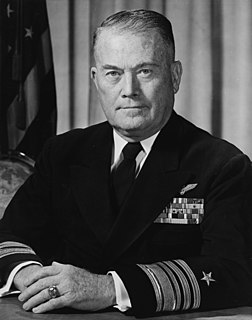
William Francis Raborn, Jr., was the United States Director of Central Intelligence from April 28, 1965 until June 30, 1966. He was also a career United States Navy officer who led the project to develop the Polaris missile system and retired from the Navy in 1963 as a Vice Admiral.
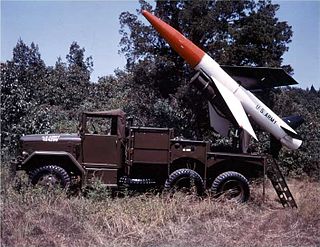
The MGM-18 Lacrosse was a short-ranged tactical weapon intended for close support of ground troops. Its first flight test was in 1954 and was deployed by the United States Army beginning in 1959, despite being still in the development stage. The program's many technical hurdles proved too difficult to overcome and the missile was withdrawn from field service by 1964.
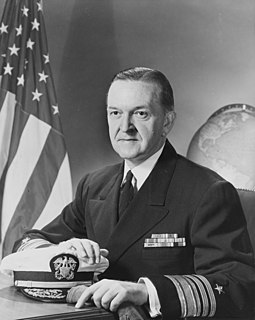
Admiral John Harold Sides was a four-star admiral in the United States Navy who served as commander in chief of the United States Pacific Fleet from 1960 to 1963 and was known as the father of the Navy's guided-missile program.

The Operational Test and Evaluation Force (OPTEVFOR) serves as an independent and objective agency within the United States Navy for the operational testing and evaluation (OT&E) of naval aviation, surface warfare, submarine warfare, C4I, cryptologic, and space systems in support Navy and U.S. Department of Defense acquisition programs.

The General Dynamics Mauler was a self-propelled anti-aircraft missile system designed to a late 1950s US Army requirement for a system to combat low-flying high-performance tactical fighters and short-range ballistic missiles.

The Bold Orion missile, also known as Weapons System 199B (WS-199B), was a prototype air-launched ballistic missile (ALBM) developed by Martin Aircraft during the 1950s. Developed in both one- and two-stage designs, the missile was moderately successful in testing, and helped pave the way for development of the GAM-87 Skybolt ALBM. In addition, the Bold Orion was used in early anti-satellite weapons testing, performing the first interception of a satellite by a missile.
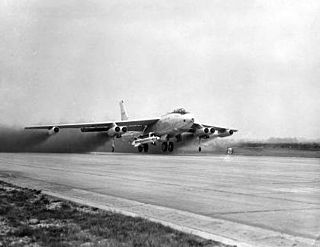
Weapons System 199 (WS-199) was a weapons development program conducted by the United States Air Force to research and develop new strategic weapons systems for Strategic Air Command. Two air-launched and one ground-launched vehicles were developed as part of the program. While none entered production, they assisted in the development of both the GAM-87 Skybolt air-launched ballistic missile and that of re-entry vehicles for ballistic missiles.
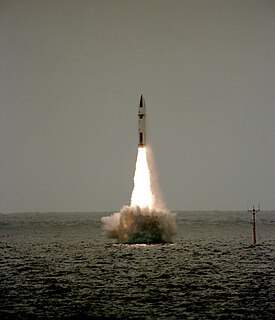
The United Kingdom's Polaris programme, officially named the British Naval Ballistic Missile System, provided its first submarine-based nuclear weapons system. Polaris was in service from 1968 to 1996.
Project production management (PPM) is the application of operations management to the delivery of capital projects. The PPM framework is based on a project as a production system view, in which a project transforms inputs into outputs.

United States Navy Special Projects Office (SPO) is a former research and design office of the United States Navy, responsible for the coordination of the development and design of the US Navy Fleet Ballistic Missiles (FBM) Polaris and Poseidon.
Donald G. Malcolm was an American organizational theorist, Professor and Dean at Cal State L.A.'s College of Business and Economics and management consultant, known as co-developer of the Performance, Evaluation, and Review Technique (PERT).
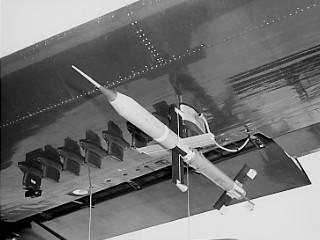
The ASM-N-6 Omar was a short-range air-to-surface missile developed for and evaluated by the United States Navy in the early 1950s. Intended to use existing unguided rockets as a basis and using a novel guidance system involving optical beam-riding, the program was unable to resolve difficulties with the guidance system and was cancelled without entering service.
References
- ↑ United States. Congress. House. Committee on Government Operations (1962), Systems Development and Management: June 21–29, July 31, August 15, 1962. U.S. Government Printing Office, 1962. p. 582
- ↑ James Jerome O'Brien, Fredric L. Plotnick (1999), CPM in Construction Management, p. 7
- 1 2 Cornell University. "News of Alumni," Cornell Alumni News, Vol 50, nr. 3. October 1, 1947. p. 25
- ↑ University of Texas. Bureau of Business Research (1966), Studies in Personnel and Management. Nr. 18. p. 11.
- ↑ James Jerome O'Brien (1969) Scheduling handbook. p. 73; cited in O'Brien and Plotnick (1999, 7).
- 1 2 Frederick I. Ordway, Advances in Space Science and Technology. Vol. 6, 2014. p. 221.
- ↑ Fazar (1959), cited in: Möhring, Rolf H. "D. Ray Fulkerson and Project Scheduling." Documenta Mathematica · Extra Volume ISMP (2012) 211–219
- ↑ Missiles and Rockets. Vol. 8, 1961, p. 28